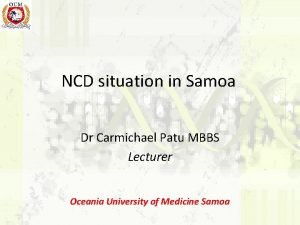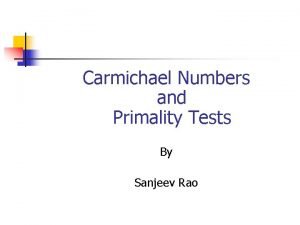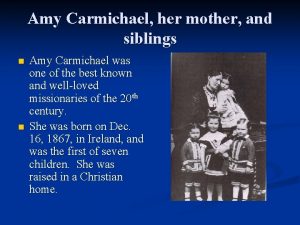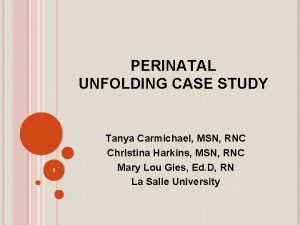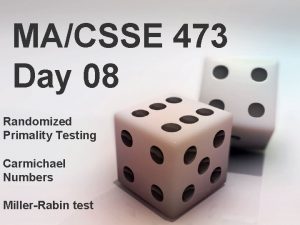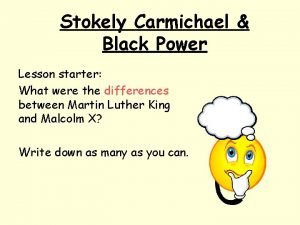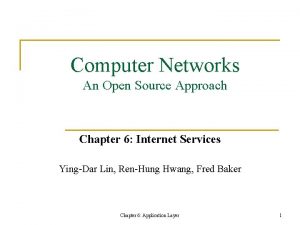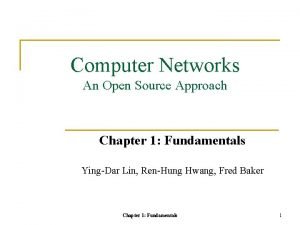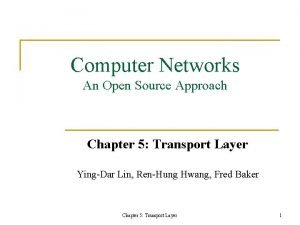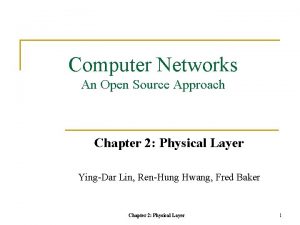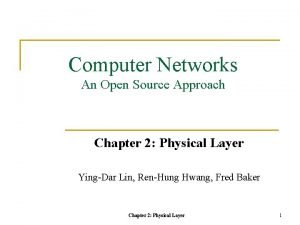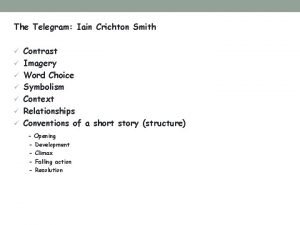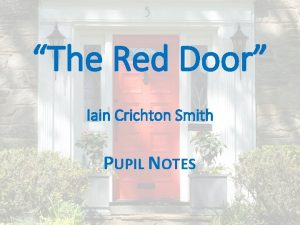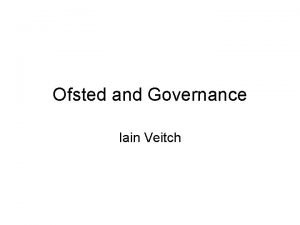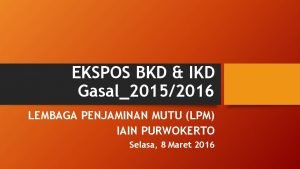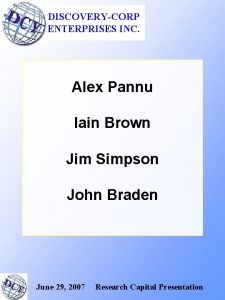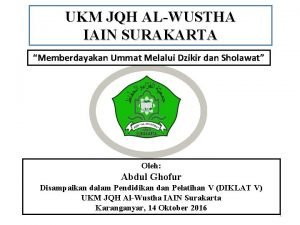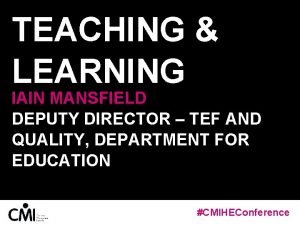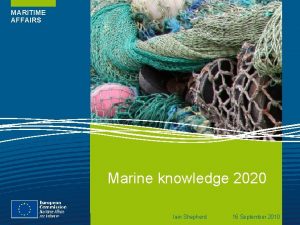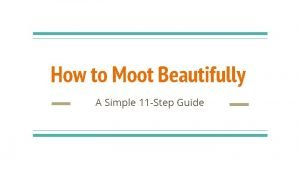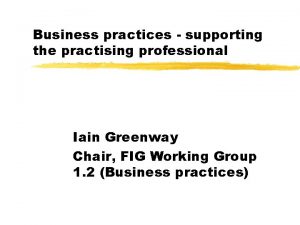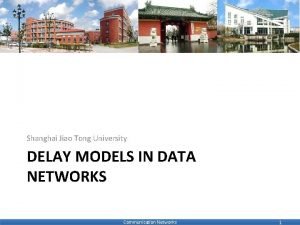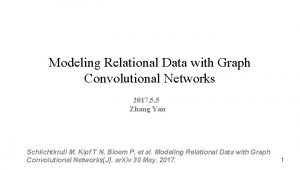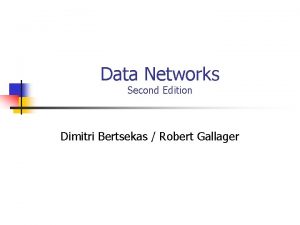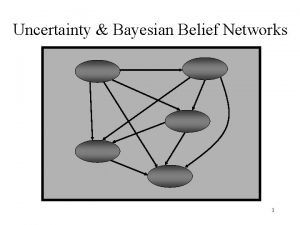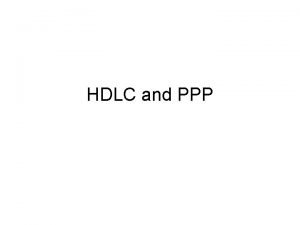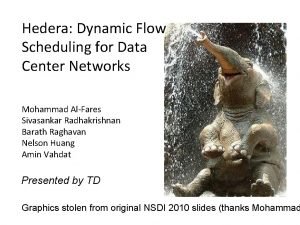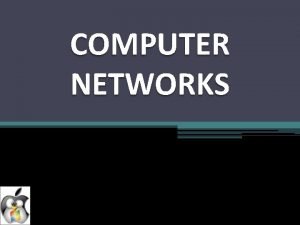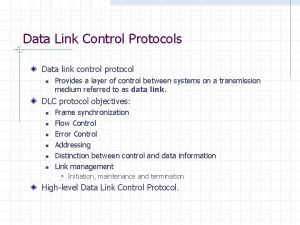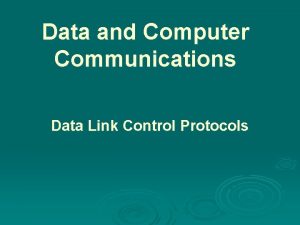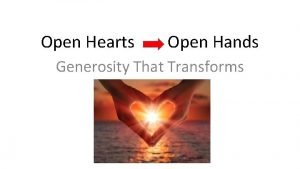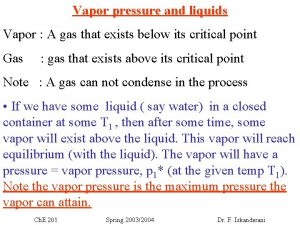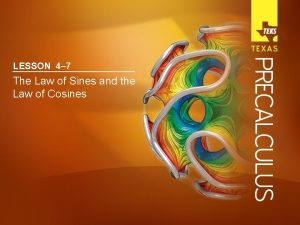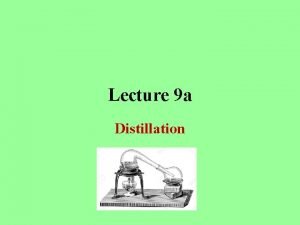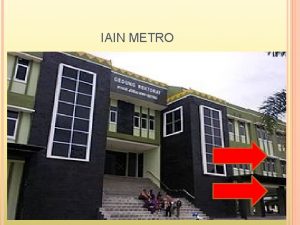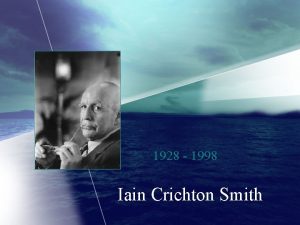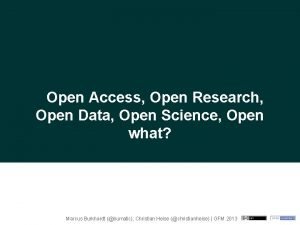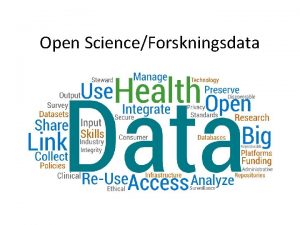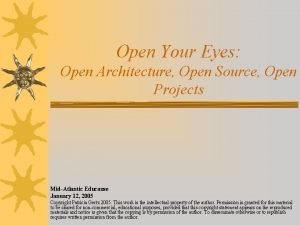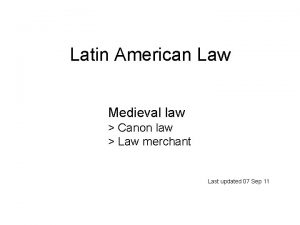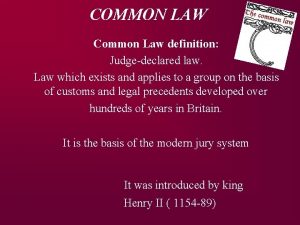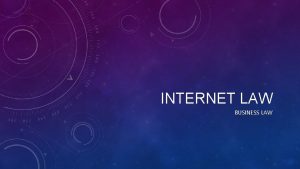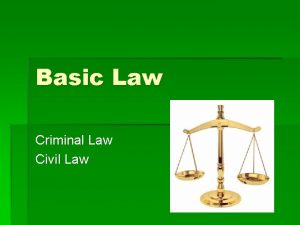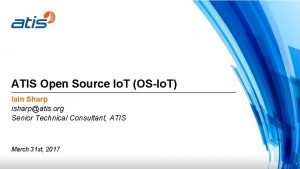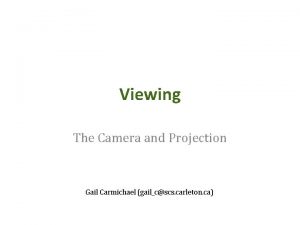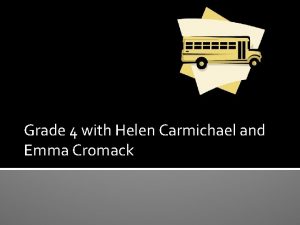Open Data Networks and the Law Iain Carmichael































































































- Slides: 95

Open Data, Networks and the Law Iain Carmichael and Michael Kim Py. Data Carolinas 2016

Court opinions are legally binding for future cases Stare Decisis means courts are bound by themselves and superior courts should follow precedent should not overturn precedent without good reason

open data networks important cases community detection

Judicial opinions are published in books called reporters

Most major digital sources of legal data are not free Lexis. Nexis, Bloomberg Law and West. Law all cost money

Most major digital sources of legal data are not free Lexis. Nexis, Bloomberg Law and West. Law all cost money Large law firms pay for services

Most major digital sources of legal data are not free Lexis. Nexis, Bloomberg Law and West. Law all cost money Large law firms pay for services Legal data is not owned by anyone

Free Law Project 501(c)(3) non-profit @freelawproject @mlissner to provide free, public, and permanent access to primary legal materials on the Internet for educational, charitable, and scientific purposes to the benefit of the general public and the public interest

Court Listener ~ 3 million legal opinions opinion text, citations, date, judges, etc

Court Listener ~ 3 million legal opinions opinion text, citations, date, judges, etc Judge database judicial appointers, biographical data, political affiliations, etc

Court Listener ~ 3 million legal opinions opinion text, citations, date, judges, etc Judge database judicial appointers, biographical data, political affiliations, etc Oral arguments 800, 000 minutes (and counting) of audio currently being transcribed by Google’s Speech to Text API

Other free, digital sources of legal data Ravel Justia Oyez Google Scholar Legal Information Institute

Court Listener makes bulk download of large amounts of legal data easy single click download of 3 million court opinions 30 GB of compressed data includes citations

Court Listener offers a case recommendation system Cite. Geist is based on a keyword search and a measure relevancy determined by citations

open data networks important cases community detection

What is a Network? Iain Abby Sam Dan a network is a set of nodes people in a social network

What is a Network? Iain Abby a network is a set of nodes people in a social network and edges Abby and Iain are FB friends Sam Dan

Kinds of Networks Nodes can have properties name, text, physical location Edges can be directed links from one website to another Edges can have weights number of white-matter fibers connecting two regions of the brain

Social Networks: connections between people

Brain Networks: white matter fiber tracts connecting different regions of the brain Human Connectome Project, 2016 Neurodata. io, 2016

Legal case citation network Nodes are court opinions case text, date, judges, jurisdiction, political alignment Brown v. Board Mc. Laurin Sweatt Shelley Mc. Cabe Sipuel Gains

Legal case citation network Nodes are court opinions case text, date, judges, jurisdiction, political alignment Brown v. Board Mc. Laurin Sweatt Shelley Sipuel Gains Edges are directed, no cycles ~3 million cases ~30 million citations Mc. Cabe

SCOTUS sub-network Focus on only cases in the Supreme Court of the United States 30, 000 cases 250, 000 citations between SCOTUS cases

We used two graph packages Network. X written in Python good documentation i. Graph written in C, wrapped in Python and R poor documentation in python

What can networks tell us about the law? What are the most important cases? what does important mean? How does legal precedent evolve? Can we build an even better case recommendation system?

open data networks important cases community detection in-degree closeness centrality Page. Rank Others

Visualizing large networks is hard physics based heuristic layout approximates the equilibrium state of a certain physical system made of springs aims to minimize edge crossings make edge lengths as uniform other heuristic layouts did not do any better

In-degree and closeness centrality

Vertex in-degree = how many times were you cited

Closeness centrality is based on a notion of distance between nodes in a graph

Shortest path between two nodes is a reasonable measure of distance between nodes Iain Abby Sam Dan

Shortest path between two nodes is a reasonable measure of distance between nodes Iain Abby d(Sam, Abby) = 2 Sam Dan

In a directed graph you can only travel along the direction of the edge Iain Abby Sam Dan

In a directed graph you can only travel along the direction of the edge Sam can walk to Dan Iain Sam Abby Dan can not walk to Sam A case in 2000 can cite a case in 1900 A case in 1900 can not cite a case in 2000

Closeness Centrality measures how “close” a vertex is to all other vertices in the graph

Closeness Centrality measures how “close” a vertex is to all other vertices in the graph if d(V, c) is small for most cases c then closeness(v) is large

Closeness Centrality measures how “close” a vertex is to all other vertices in the graph if d(V, c) is small for most cases c then closeness(v) is large have to compute all pairs shortest paths which is slow in a large network cubic in the number of nodes

Network. X can be on large networks Network. X i. Graph 7 hours for all pairs shortest paths 5 minutes for all pairs shortest paths

Who is the most important node? A B

Degree centrality says B is the most important case A B

Closeness centrality says A is the most important case A B

Closeness centrality says A is the most important case A connects two separate clusters of nodes A B

SCOTUS cases ranked by in-degree

Network metadata can help make useful large network visualizations

Network metadata can help make useful large network visualizations In-degree 600 300 100 Date 1900 2000

One case immediately stands out in the in-degree plot US v. Detroit Timber and Lumber Company 600 In-degree ~600 citations, all fairly recent 300 1900 2000 twice as many citations as every other case

US v. Detroit is not an important case Law reporters (the books) sometimes include cliff notes about cases

US v. Detroit is not an important case Law reporters (the books) sometimes include cliff notes about cases Lawyers started citing the commentary as law

US v. Detroit is not an important case Law reporters (the books) sometimes include cliff notes about cases Lawyers started citing the commentary as law Supreme court recently ruled against this practice

Reporters now include a warning that cites the Detroit case

SCOTUS cases ranked by Closeness Centrality

Closeness Centrality Closeness centrality of the directed graph is strongly correlated with date Date 1900 2000

Closeness Centrality on the undirected graph is more meaningful Date 1900 2000

Closeness Centrality on the undirected graph favors procedural cases Top SCOTUS cases by closeness centrality 1. Ashwander v. TVA (1936): Constitutional Avoidance 2. Erie RR v. Tompkins (1938): Federal courts must apply state law 3. Crowell v. Benson (1932): Adjudication by administrative agencies 4. Baker v. Carr (1962): Voting rights, redistricting is judiciable 5. Burnet v. Coronado Oil and Gas (1932): Stare Decisis, cited in Erie 6. Cohens v. Virginia (1821): SCOTUS review of criminal trials w/constitutional question 7. Monroe v. Pape (1961): 1983 can be used to sue state officers 8. Glidden Co. v. Zdanok (1962): Courts of Claims and Patent appeal = Article 3 9. Yakus v US (1944): Admin law, delegation 10. Ex Parte Young (1908): Allows suits against state officials

Procedural cases connect disparate areas of law procedural law is about how the courts operate can be some of the most important cases two cases about unrelated topics may cite a procedural case

Closeness Centrality on the undirected graph favors procedural cases Top SCOTUS cases by closeness centrality 1. Ashwander v. TVA (1936): Constitutional Avoidance 2. Erie RR v. Tompkins (1938): Federal courts must apply state law 3. Crowell v. Benson (1932): Adjudication by administrative agencies 4. Baker v. Carr (1962): Voting rights, redistricting is judiciable 5. Burnet v. Coronado Oil and Gas (1932): Stare Decisis, cited in Erie 6. Cohens v. Virginia (1821): SCOTUS review of criminal trials w/constitutional question 7. Monroe v. Pape (1961): 1983 can be used to sue state officers 8. Glidden Co. v. Zdanok (1962): Courts of Claims and Patent appeal = Article 3 9. Yakus v US (1944): Admin law, delegation 10. Ex Parte Young (1908): Allows suits against state officials Erie Rail Road v. Tompkins is about what body of law federal courts may rely on

Closeness Centrality picked cases that connected disparate clusters of cases A connects two separate clusters of nodes A B

Page. Rank

Page. Rank ranks vertices in a directed network a case is important if it is cited frequently and by other important cases Page. Rank is at the heart of Google’s search algorithm Page is a play on web page and Larry Page

Page. Rank was designed for the network of websites Nodes are websites Directed edges are hyperlinks from one page to another There can be loops

Imagine randomly surfing the web for a long time Iain’s website NY Times Facebook Huff. Po go to a new website by randomly clicking a link from the current website

Imagine randomly surfing the web for a long time go to a new website by randomly clicking a link from the current website Iain’s website NY Times Facebook Huff. Po occasionally pick a website completely at random could be one that is not necessarily linked to the current page

How long did you spend on Facebook? the proportion of the time you spend on a website is its Page. Rank value

How long did you spend on Facebook? the proportion of the time you spend on a website is its Page. Rank value it is the stationary distribution of this random walk can be computed efficiently

SCOTUS cases ranked by Page. Rank

Page. Rank tends to pick out older cases that precede landmark cases Top SCOTUS cases by Page. Rank 1. Boyd v. US (1886): Compulsion of Documents = 4 th amendment violation 2. Brown v. Maryland (1827): Commerce clause, international trade 3. Slaughter House Cases (1873): 14 th amendment beginnings 4. Martin v. Hunter’s Lessee (1816): SCOTUS can review state supreme courts 5. Davidson v. New Orleans (1877): 14 th amendment beginnings 6. Weeks v. United States (1914): Fourth amendment seizures, exclusion of evidence 7. Ex Parte Lange (1874): Double jeopardy 8. Cohens v. Virginia (1821): SCOTUS review of criminal trials w/constitutional question 9. Murray's Lessee v. Hoboken Land & Improvement (1856): Due process and debt

Page. Rank tends to pick out older cases that precede landmark cases Top SCOTUS cases by Page. Rank 1. Boyd v. US (1886): Compulsion of Documents = 4 th amendment violation 2. Brown v. Maryland (1827): Commerce clause, international trade 3. Slaughter House Cases (1873): 14 th amendment beginnings 4. Martin v. Hunter’s Lessee (1816): SCOTUS can review state supreme courts 5. Davidson v. New Orleans (1877): 14 th amendment beginnings 6. Weeks v. United States (1914): Fourth amendment seizures, exclusion of evidence 7. Ex Parte Lange (1874): Double jeopardy 8. Cohens v. Virginia (1821): SCOTUS review of criminal trials w/constitutional question 9. Murray's Lessee v. Hoboken Land & Improvement (1856): Due process and debt first cases about the 14 th Amendment slightly expanded the interpretation

Page. Rank tends to pick out older cases that precede important cases Top SCOTUS cases by Page. Rank 1. Boyd v. US (1886): Compulsion of Documents = 4 th amendment violation 2. Brown v. Maryland (1827): Commerce clause, international trade 3. Slaughter House Cases (1873): 14 th amendment beginnings 4. Martin v. Hunter’s Lessee (1816): SCOTUS can review state supreme courts 5. Davidson v. New Orleans (1877): 14 th amendment beginnings 6. Weeks v. United States (1914): Fourth amendment seizures, exclusion of evidence 7. Ex Parte Lange (1874): Double jeopardy 8. Cohens v. Virginia (1821): SCOTUS review of criminal trials w/constitutional question 9. Murray's Lessee v. Hoboken Land & Improvement (1856): Due process and debt first cases about the 14 th Amendment began expanding the interpretation not important by itself led to the Civil Rights Act and legalization of gay marriage

Page. Rank favors older cases 1800 Date 1900 2000

Page. Rank Erie RR is ranked 94 thby Page. Rank 1800 Date 1900 2000

Page. Rank Detroit Lumber is ranked 65 th by Page. Rank 1800 Date 1900 2000

Why Page. Rank favors older cases

Page. Rank in a DAG in a direct, acyclic graph the random surfer will usually go backwards in time 2015 2010 2005 the random walk prefers to hang out in older cases 2000

Page. Rank in a DAG in a direct, acyclic graph the random surfer will usually go backwards in time 2015 2010 2005 the random walk prefers to hang out in older cases 2000

Other measures of vertex importance

Betweenness centrality is similar to closeness centrality seeks cases that tend to lie “between” other cases also favored procedural cases

Hubs/authorities and eigenvector centrality picked similar cases a case is important if it is cited a lot by other important cases both favor substantive cases First Amendment law Authority scores match well with legal expert opinion (Fowler et all, 2008)

Authority Score Authority scores are a promising metric 1800 Date 1900 2000

Authority Score Authority did not identify Detroit Lumber as a top 10 case 1800 Date 1900 2000

Authority Score Authority scores favor cases from the middle of the 20 th century 1800 Date 1900 2000

Every dog has its day there is not a best measure of case importance different measures favor different latent qualities

Improvements to case recommendation system use other notions of vertex importance authorities score implement multiple recommendation systems procedural vs. substantive include time decay term for case quality

Community Detection

Community detection clusters the nodes in a network A community is a group of nodes that are densely connected to each other, but sparsely connected with the rest of the graph Stanley 2016

Community Detection applied James’ Facebook network discovered his college friends and high school friends Extraction of Statistically Significant Communities discovered 7 communities Nobel, 2016 Wilson, 2013

Community detection is unsupervised learning Optimization Spectral Clustering (Ng et al, 2002) Min-cut (Goldberg et al, 1998) MLE or posterior inference Stochastic Block Model (Snijders, 1997) Statistical significance ESSC (Wilson et al, 2014) Modularity (Newman et al, 2004) Random Walktrap (Pons et al) Hierarchical clustering Edge Betweenness (Newman et al, 2002)

There are several communities we might expect to find in the legal citation network Court jurisdictions SCOTUS, NC court of appeals, etc Geography North East Areas of the law

Summary

Major points Open legal data is important because court opinions are law Different notions of vertex importance get at different latent qualities Page. Rank favors older cases in a citation network

Future Work

Fit probabilistic models for network growth Preferential attachment with aging PA using other measures of vertex importance Include covariates opinion text, judge, jurisdiction, date

Use the text data of the opinions and the citation network Compare text based opinion clustering with network based opinion clustering Topic modeling Use both text and citation information to infer communities

Contributors Brendan Schneiderman Iain Carmichael James Jushchuk James Wudel Michael Kim Shankar Bhamidi https: //github. com/idc 9/law-net

References • • • Goldberg, Andrew V. , and Kostas Tsioutsiouliklis. "Cut Tree Algorithms: An Experimental Study. " Journal of Algorithms 38. 1 (2001): 51 -83. Web. Kolaczyk, Eric D. Statistical Analysis of Network Data: Methods and Models. New York: Springer, 2009. Print. Murphy, Kevin P. Machine Learning: A Probabilistic Perspective. Cambridge, MA: MIT, 2012. Print. Newman, M. E. J. , and M. Girvan. "Finding and Evaluating Community Structure in Networks. " Physical Review E Phys. Rev. E 69. 2 (2004): n. pag. Web. Newman, M. E. J. , and M. Girvan. "Community Structure in Social and Biological Networks. " Proc. Natl. Acad. Sci. 99. 12 (2002): 7821 -826. Web. Ng, Andrew Y. , Michael Jordan I. , and Yair Weiss. "On Spectral Clustering: Analysis and an Algorithm. " NIPS Conference (2002): n. pag. Web. Pons, Pascal, and Matthieu Latapy. "Computing Communities in Large Networks Using Random Walks. " Computer and Information Sciences - ISCIS 2005 Lecture Notes in Computer Science (2005): 284 -93. Web. Snijders, Tom A. b. , and Krzysztof Nowicki. "Estimation and Prediction for Stochastic Blockmodels for Graphs with Latent Block Structure. " Journal of Classification 14. 1 (1997): 75 -100. Web. Wilson, James D. , Simi Wang, Peter Mucha J. , Shankar Bhamidi, and Andrew Nobel B. "A Testing Based Extraction Algorithm for Identifying Significant Communities in Networks. " The Annals of Applied Statistics 8. 3 (2014): 1853 -891. Web.

References • Human Connectome Project. http: //www. humanconnectomeproject. org/, n. d. Web. 10 Sept. 2016. • Neurodata. http: //neurodata. io/, n. d. Web. 10 Sept. 2016. Lecture. • Stanley, Natalie. “Communities in Networks” 14 Feb 2016 • Nobel, Andrew. “Community Detection” 10 Sept 2016, STOR 767: Advanced Machine Learning. Lecture.
 Virtual circuit and datagram networks
Virtual circuit and datagram networks Newton's first law and second law and third law
Newton's first law and second law and third law Newton's first law and second law and third law
Newton's first law and second law and third law 영국 beis
영국 beis Basestore iptv
Basestore iptv Zach carmichael
Zach carmichael Dr carmichael patu
Dr carmichael patu Carmichael numbers list
Carmichael numbers list Amy carmichael death
Amy carmichael death Bubblehep
Bubblehep Carmichael numbers
Carmichael numbers Stokely carmichael importance
Stokely carmichael importance Boyles law
Boyles law How to calculate boyle's law
How to calculate boyle's law Computer networks an open source approach
Computer networks an open source approach Computer networks an open source approach
Computer networks an open source approach Computer networks an open source approach
Computer networks an open source approach Computer networks an open source approach
Computer networks an open source approach Computer networks an open source approach
Computer networks an open source approach The telegram by iain crichton smith
The telegram by iain crichton smith The telegram analysis
The telegram analysis Iain crichton smith the telegram
Iain crichton smith the telegram The red door annotations
The red door annotations Sipakatau iain palopo
Sipakatau iain palopo Iain veitch
Iain veitch Lbkd iain purwokerto
Lbkd iain purwokerto Iain giles cibc
Iain giles cibc Iain moffat
Iain moffat Ukm iain surakarta
Ukm iain surakarta Iain mansfield
Iain mansfield Iain shepherd
Iain shepherd Iain morley oxford
Iain morley oxford Iain greenway
Iain greenway Iain crichton smith the telegram
Iain crichton smith the telegram Adjunct display
Adjunct display Chef pic
Chef pic Hình ảnh bộ gõ cơ thể búng tay
Hình ảnh bộ gõ cơ thể búng tay Slidetodoc
Slidetodoc Bổ thể
Bổ thể Tỉ lệ cơ thể trẻ em
Tỉ lệ cơ thể trẻ em Voi kéo gỗ như thế nào
Voi kéo gỗ như thế nào Tư thế worm breton
Tư thế worm breton Chúa yêu trần thế alleluia
Chúa yêu trần thế alleluia Các môn thể thao bắt đầu bằng tiếng nhảy
Các môn thể thao bắt đầu bằng tiếng nhảy Thế nào là hệ số cao nhất
Thế nào là hệ số cao nhất Các châu lục và đại dương trên thế giới
Các châu lục và đại dương trên thế giới Công thức tính độ biến thiên đông lượng
Công thức tính độ biến thiên đông lượng Trời xanh đây là của chúng ta thể thơ
Trời xanh đây là của chúng ta thể thơ Mật thư tọa độ 5x5
Mật thư tọa độ 5x5 101012 bằng
101012 bằng độ dài liên kết
độ dài liên kết Các châu lục và đại dương trên thế giới
Các châu lục và đại dương trên thế giới Thể thơ truyền thống
Thể thơ truyền thống Quá trình desamine hóa có thể tạo ra
Quá trình desamine hóa có thể tạo ra Một số thể thơ truyền thống
Một số thể thơ truyền thống Bàn tay mà dây bẩn
Bàn tay mà dây bẩn Vẽ hình chiếu vuông góc của vật thể sau
Vẽ hình chiếu vuông góc của vật thể sau Thế nào là sự mỏi cơ
Thế nào là sự mỏi cơ đặc điểm cơ thể của người tối cổ
đặc điểm cơ thể của người tối cổ V cc
V cc Vẽ hình chiếu đứng bằng cạnh của vật thể
Vẽ hình chiếu đứng bằng cạnh của vật thể Phối cảnh
Phối cảnh Thẻ vin
Thẻ vin đại từ thay thế
đại từ thay thế điện thế nghỉ
điện thế nghỉ Tư thế ngồi viết
Tư thế ngồi viết Diễn thế sinh thái là
Diễn thế sinh thái là Các loại đột biến cấu trúc nhiễm sắc thể
Các loại đột biến cấu trúc nhiễm sắc thể Số nguyên tố là số gì
Số nguyên tố là số gì Tư thế ngồi viết
Tư thế ngồi viết Lời thề hippocrates
Lời thề hippocrates Thiếu nhi thế giới liên hoan
Thiếu nhi thế giới liên hoan ưu thế lai là gì
ưu thế lai là gì Khi nào hổ mẹ dạy hổ con săn mồi
Khi nào hổ mẹ dạy hổ con săn mồi Khi nào hổ con có thể sống độc lập
Khi nào hổ con có thể sống độc lập Hệ hô hấp
Hệ hô hấp Từ ngữ thể hiện lòng nhân hậu
Từ ngữ thể hiện lòng nhân hậu Thế nào là mạng điện lắp đặt kiểu nổi
Thế nào là mạng điện lắp đặt kiểu nổi Delay models in data networks
Delay models in data networks Modeling relational data with graph convolutional networks
Modeling relational data with graph convolutional networks Data networks bertsekas
Data networks bertsekas Data link layer switching in computer networks
Data link layer switching in computer networks Bayesian belief networks in data mining
Bayesian belief networks in data mining Data link
Data link Link
Link Data encoding techniques
Data encoding techniques Hedera: dynamic flow scheduling for data center networks
Hedera: dynamic flow scheduling for data center networks Elementary data link protocols in computer networks
Elementary data link protocols in computer networks High level data link control protocol
High level data link control protocol Data link control
Data link control On delay timer symbol
On delay timer symbol Open hearts open hands
Open hearts open hands Raoult's law and dalton's law
Raoult's law and dalton's law What is a civil law
What is a civil law 4-7 the law of sines and the law of cosines answers
4-7 the law of sines and the law of cosines answers Raoult's law and dalton's law
Raoult's law and dalton's law






